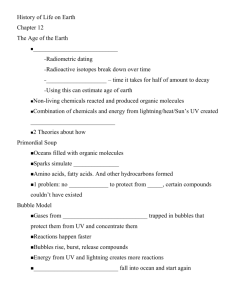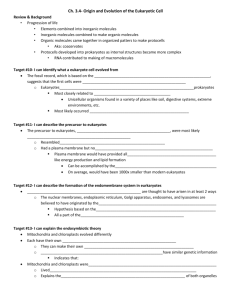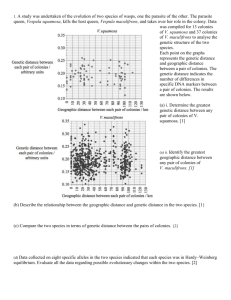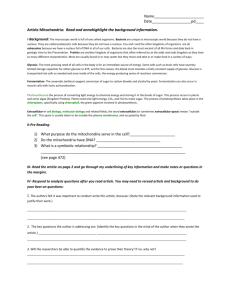BioCh12NotesMOD
advertisement
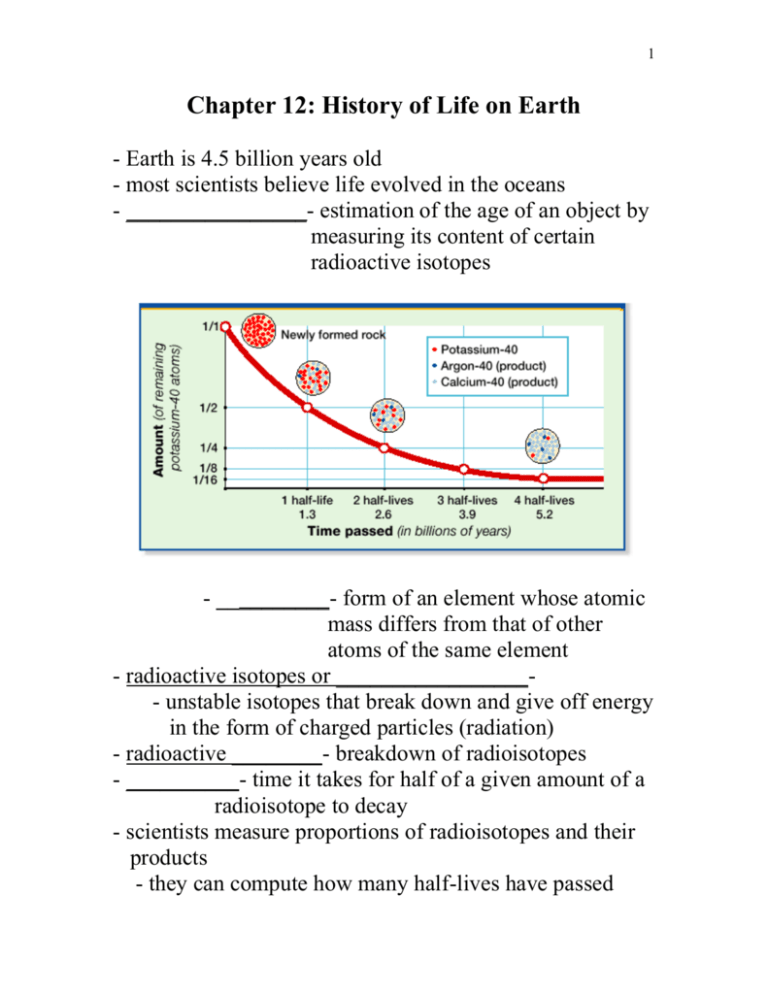
1 Chapter 12: History of Life on Earth - Earth is 4.5 billion years old - most scientists believe life evolved in the oceans - ________________- estimation of the age of an object by measuring its content of certain radioactive isotopes - __________- form of an element whose atomic mass differs from that of other atoms of the same element - radioactive isotopes or _________________- unstable isotopes that break down and give off energy in the form of charged particles (radiation) - radioactive ________- breakdown of radioisotopes - __________- time it takes for half of a given amount of a radioisotope to decay - scientists measure proportions of radioisotopes and their products - they can compute how many half-lives have passed 2 Evolution of Cellular Life - _____- preserved or mineralized remains or imprint of an organism that lived long ago - oldest fossils: microscopic prokaryotes are found in rock that is 2.5 _____ (billion years old) - __________bacteria- photosynthetic bacteria - single celled organisms - released O2 into the air as it photosynthesized - O2 was scarce beforehand - today O2 makes up 21% of Earth’s atmosphere 2 groups of Prokaryotes 1) Eu_________- prokaryotes that contain peptidoglycan in their cell walls - Escherichia coli (E. coli) - bacteria that causes disease and decay 2) _______bacteria- prokaryotes that lack peptidoglycan in cell walls and have unique lipids in their cell membranes - thought to resemble first prokaryotes to have existed on earth - Eukaryotic cells more likely ________ from archaebacteria than from eubacteria 3 - 1.5 bya (billion years ago) the first eukaryotes appeared - complex system of internal membranes - ______ is enclosed within a nucleus - most have _______________- chloroplasts are found in protists and plants - mitochondria and chloroplasts are size of prokaryotes and contain their own DNA - mitochondria and chloroplasts originated by theory of _________________ - theory proposes that mitochondria are descendants of symbiotic, aerobic eubacteria and chloroplasts are descendants of symbiotic, photosynthetic eubacteria - bacteria entered large cells either as ___________ or undigested _____________ - bacteria began to live inside the host cell where they performed either respiration (mitochondria) or photosynthesis (chloroplasts) - mitochondria and chloroplasts have characteristics similar to those of bacteria 4 Evidence 1) ___________ and ______________ - mitochondria are about the same size as most Eubacteria and chloroplasts are the same size as some cyanobacteria - mitochondria and chloroplasts are surrounded by two membranes - smooth outer membrane derived from ER of host cell - inner membrane is folded like cell membrane of aerobic Eubacteria - inside 2nd membrane are proteins that carry out cellular respiration - chloroplasts and cyanobacteria contain ____________ 2) _______________ material - mitochondria and chloroplasts have ________DNA similar to bacteria - both mitochondria and chloroplasts contain genes that are __________ from those found in the nucleus of the host cell 3) _____________ - mitochondrial and chloroplasts ribosomes have size and structure similar to bacterial ribosomes 4) _________________ - mitochondria and chloroplasts reproduce by simple fission…like bacteria - takes place independently of cell cycle of host cell 5 6 kingdoms - includes all living organisms 1) _______- kingdom that includes a large, varied group of organisms…misfits - multi and unicellular organisms - 1st eukaryotic kingdom 2) ________________- single celled prokaryotes 3) ________________- single celled prokaryotes 4) plants- discuss later 5) animals- discuss later 6) fungi- discuss later - _____________ body plan organisms make ½ of the total biomass (total weight of living and non-living things) - cell must carry out all functions of organism - cells in multi-cellular organisms are specialized - most protists are single celled, some are multi-cellular - important in evolution of life on Earth - oldest known fossils of multi-cellular organism in 700 myo rocks - some did not produce diverse groups of organisms - Ex.- red, brown, green algae (sea weed) - some produced plants, animals, and fungi - most of today’s phyla originated during the ___________ period - 540 to 505 mya - many Cambrian fossils found in 1909 in Burgess Shale in ____________ - no known organisms alive today that resemble many of the organisms found 6 - Ordovician period, 505 to 430 mya - many animals in sea including trilobites…now extinct st - 1 mass extinction; 440 mya, sudden change took place - _____________- episode during which large numbers of species became extinct - 2nd mass extinction; 360 mya - 3rd mass extinction; 245 mya - most devastating - end of Permian period - about _______of all animal species became extinct - 4th mass extinction; 280 mya - 5th mass extinction; 65 mya - discuss later in more detail - included _____ of all land species including dinosaurs - specific causes are unknown - likely that geological and weather changes were factors - some believe 6th mass extinction is occurring today - destruction of _________ _______ forest - already have lost ½ of forests - if it continues; 22% to 47% of plant species will be lost as well as 2000 of worlds 9000 species of birds and countless insect species Life Invades the Land - life formed in seas where it was protected from the sun’s _____ rays - 2.5 bya photosynthesis by cyanobacteria began adding ____________ to Earth’s atmosphere - oxygen reacted in upper atmosphere - sun’s UV rays caused some O2 to produce O3 (_____) - ozone blocked UV rays 7 - after millions of years enough O3 existed to make life on land safe - _____________- symbiotic association between fungi and roots of plants - fungus provides minerals to the plant and the plant provides nutrients to the fungus - ___________- relationship between two species in which both species benefit - plants and fungi were first organisms to live on land - plants used sun energy to make nutrients - couldn’t get nutrients from bare rock - fungi cannot make their own nutrients, but can absorb minerals from bare rock -plants and fungi lived together on land about 430 mya - 100 million years later plants covered Earth’s surface - land plants provided food for land dwelling animals - 1st animals to go from sea to land were arthropods - ___________- type of animal with hard outer skeleton, segmented body, and paired, jointed limbs - Ex.- lobsters, crabs, insects, spiders - type of ___________ was the first to live on land - insects evolved from first land dwellers - now very diverse - evolutionary success due to ability to _______ - 1st animals to have wings - allowed for efficient search for food, mates, and nesting sites - led to partnership with plants - oldest fossils of flowering plants about 127 myo - probably older 8 - ______________- animal with a backbone - 1st vertebrates were small, jawless fish - evolved 530 mya - jawed fishes appeared 430 mya - able to _______ food instead of suck it up - effective predators - fishes are most successful living vertebrates - make up more than ½ of all modern vertebrate species - became very successful in water - needed to change to go to land - _____________- smooth skinned, 4 legged animals - ex.- frogs, toads, salamanders - came on land 370 mya - changes that allowed them to live on land included 1) ____- moist air sacs allowed them to get O2 from air 2) _______- evolved from bones of fish fins - strong support bones behind head - ___________- evolved from amphibians 340 mya - Ex.- snakes, lizards, turtles, crocs - better suited to dry land - water tight skin lost less ____________ - water tight egg - reptiles can lay eggs on land, not like amphibians which must lay eggs in water or very moist soil 9 - __________ and birds- birds evolved from feathered dinosaurs during or after the Jurassic period - ________ (reptiles with complex teeth and legs beneath their body) gave rise to mammals about same time as dinosaurs evolved during Triassic period - 5th mass extinction occurred - most dinosaurs disappeared except ancestors of birds - smaller reptiles, mammals, and birds survived - climate changes and world wasn’t as dry - birds and mammals became dominant vertebrates on land - _________ _____- movement of Earth’s land masses over Earth’s surface - explains why a large number of ___________ are found in Australia and South America… once connected

